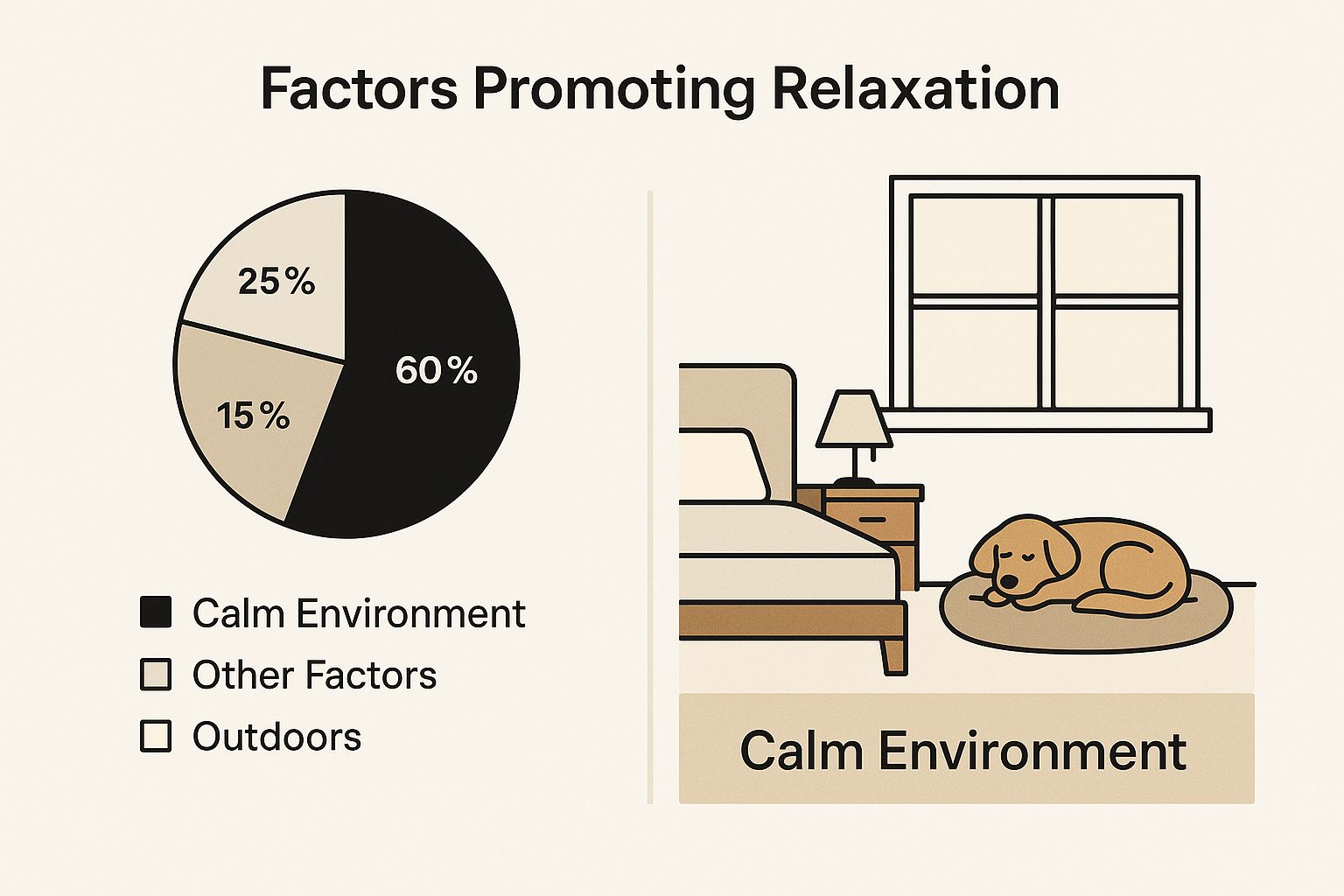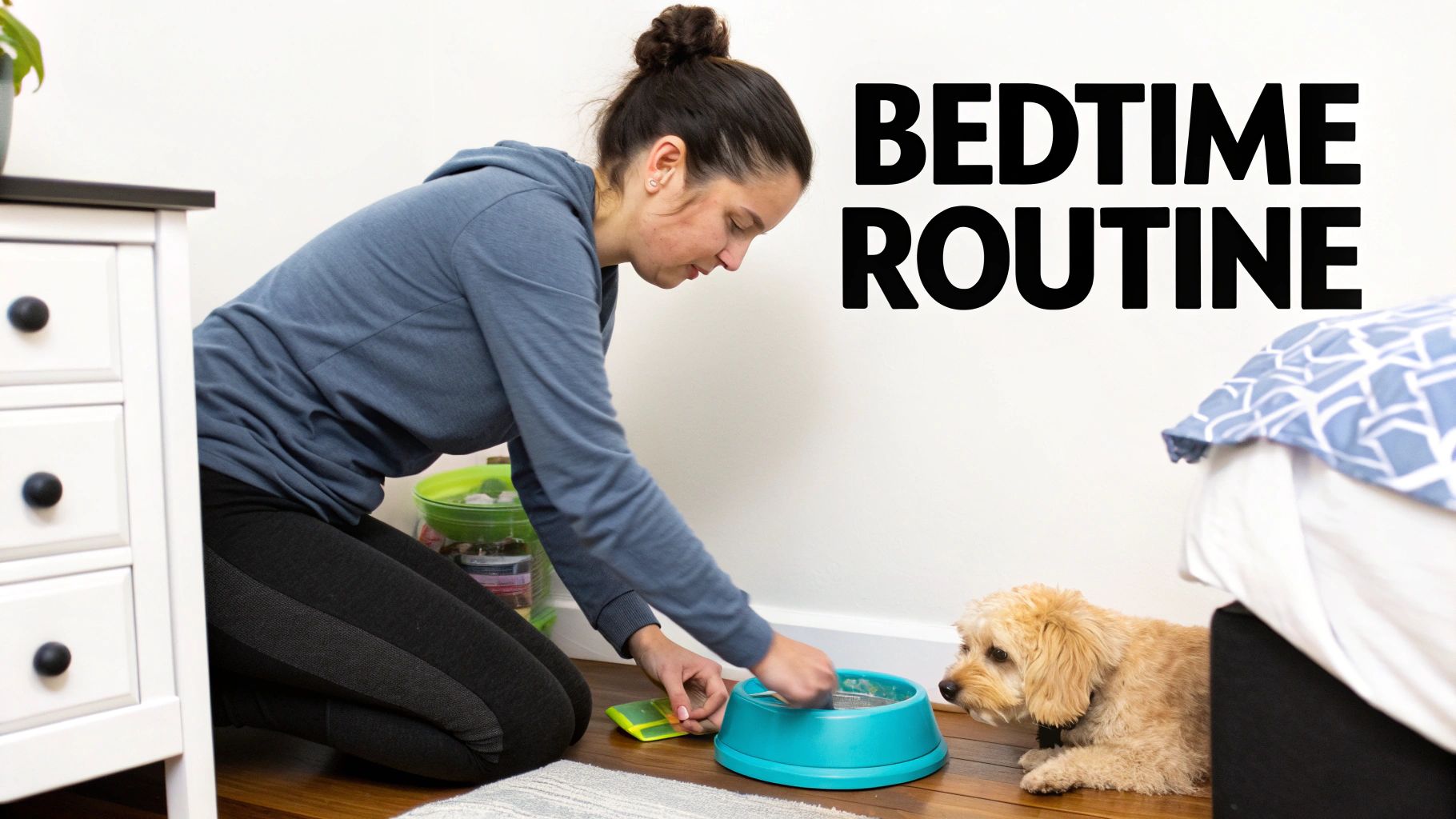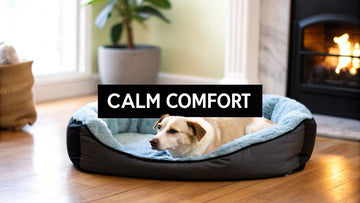Why Your Dog Becomes a Night Owl (And You Don't Have To)
When your dog starts pacing, whining, or nudging you awake just as you’re drifting off, it’s easy to feel frustrated. But understanding why they’ve suddenly turned into a nocturnal creature is the first step toward reclaiming your sleep. It's often more than just a random burst of late-night energy. Think of it less as bad behavior and more as your dog trying to tell you about an unmet need or an internal struggle.
These nighttime behaviors are frequently rooted in something deeper. For many dogs, especially those who are naturally a bit anxious, the quiet of the night can be unsettling. The sudden silence can make strange creaks, distant sirens, or the neighbor’s cat strolling through the yard feel like major threats. This heightened awareness is a key reason how to calm a restless dog at night starts with figuring out their specific triggers.
Uncovering the Root Causes
Sometimes the cause is physical. An older dog might be dealing with the onset of Canine Cognitive Dysfunction, a condition similar to dementia in humans that can disrupt sleep-wake cycles. They might feel confused or disoriented in the dark. For others, it could be joint pain from arthritis that makes it impossible to get comfortable. If your dog’s restlessness is a new development, a check-up with your vet is always a wise first move to rule out any underlying health issues.
However, psychological factors play a huge role. The shift in household routines since 2020 has had a noticeable effect on our pets. With many owners returning to the office, dogs who got used to constant company are now experiencing more separation anxiety, which can often spike at night. One recent survey highlighted a dramatic increase in canine anxiety related to stressors like other animals, jumping from 16.5% in 2020 to 43.52% in 2022. You can read more about the findings from this pet anxiety study to better understand these modern challenges.
Pent-Up Energy and Routine Changes
Finally, think about their daily activity. A dog that hasn't had enough physical or mental stimulation is like a coiled spring by bedtime. That energetic squirrel chase from the afternoon might still be replaying in their mind. This is where we, as dedicated pet parents, come in. By identifying whether the issue is pain, anxiety, or plain old boredom, we can create a targeted plan. At Flufer, we’ve learned a lot about what makes pets feel secure, and it always begins with understanding their unique point of view. The following sections will guide you through creating routines and environments that directly address these core issues, turning restless nights into peaceful slumber for you both.
Setting Up Your Dog's Sleep Sanctuary
You wouldn't sleep well on a lumpy mattress in a noisy hallway, and neither will your dog. Building a "sleep sanctuary" is a vital first step in figuring out how to calm a restless dog at night. The environment itself can either create anxiety or help soothe it. While many of us get caught up in finding the perfect bed, the real magic happens when you consider where you put it and what’s around it.
Location and Comfort Are Key
Try to see your home through your dog's eyes and ears. Is their bed shoved next to the front door, where every passing car or neighbor's footstep puts them on high alert? That’s a perfect setup for a nightly watch duty, not restful sleep. I once worked with a dog owner who saw a massive improvement just by moving their dog’s bed from the busy living room to a quiet corner of their home office. It was a simple change that removed the dog from the evening's foot traffic and noise.
A common question I get is whether a dog should sleep in the bedroom. For many dogs, especially those prone to separation anxiety, the answer is a resounding yes. The simple sound of your breathing can be incredibly reassuring. If you go this route, find a spot for their bed where they won’t get tripped over or disturbed when you get up. The idea is to offer closeness without constant disruption.
This infographic shows how the right location and a comfy bed work together to create a peaceful space for your pet.

As you can see, a true sleep sanctuary is more than just a bed—it's an entire environment designed for peace and quiet.
Dialing in the Details
Beyond just the location, other small details can make or break your dog's ability to settle down for the night. You'll want to take a closer look at a few specific elements.
To help you pinpoint potential issues, here’s a checklist comparing an ideal sleep space with one that might be causing problems.
Optimal Sleep Environment Checklist
A comprehensive comparison of ideal vs. problematic sleep environment factors for dogs
| Environmental Factor | Ideal Conditions | Common Problems | Quick Solutions |
|---|---|---|---|
| Temperature | A cool, well-ventilated room. Dogs, especially fluffy ones, sleep better when cool. | The room is stuffy, too warm, or near a heating vent. | Use a fan for air circulation, crack a window, or move the bed away from heat sources. |
| Lighting | Dim lighting or darkness. Blackout curtains block startling external lights. | Bright streetlights, motion-sensor lights outside, or bright indoor lighting. | Install blackout curtains or use a soft, low-wattage nightlight if your dog dislikes total darkness. |
| Sound | Consistent, low-level background noise like a fan or white noise machine. | Abrupt, loud noises from the street, TV, or other household members. | Play calming music, use a white noise machine, or run a quiet fan to mask disruptive sounds. |
| Bedding | A supportive bed with a raised rim to create a secure, den-like feeling. | A flat, worn-out mat on a cold floor or a bed that’s too small. | Choose a calming bed with raised edges. Our guide on the best pet bed for large dogs has great options. |
This table shows that small adjustments can lead to big improvements in your dog's comfort and security.
Now, let's break down those elements a bit more:
- Temperature: A restless dog might just be a hot dog. Breeds with thick coats can easily overheat, so a cool room is essential for deep sleep.
- Lighting: Some dogs are fine in the dark, but others feel more secure with a gentle nightlight. This can also help them avoid bumping into things if they wake up. Blackout curtains are a game-changer for blocking sudden headlights.
- Sound: Believe it or not, complete silence can make an anxious dog more jumpy. Every tiny creak becomes a major event. A white noise machine or even a simple fan provides a steady, soothing hum that can drown out startling noises from outside.
- Bedding: The right materials matter. A great bed should offer both physical comfort and a sense of security. Beds with raised rims can be particularly effective because they tap into a dog's natural instinct to nestle into a den. This simple feature helps calm their nervous system, making it easier for them to relax and drift off.
Evening Routines That Actually Tire Them Out

Here's a secret that experienced dog owners know well: a peaceful night for your pup starts hours before you even think about turning off the lights. The single best way to signal that it's time to shift from daytime play to nighttime rest is by creating a predictable evening routine. This isn't about running them ragged right before bed; it's about a gentle, calming transition.
Think of it like a bedtime routine for a child. You wouldn't go from a high-energy game of tag straight to tucking them in. Instead, you'd probably read a story, give them a warm bath, or play some soft music. Our dogs need a similar "power-down" sequence. This consistency builds a powerful sense of security, which is the foundation for solving how to calm a restless dog at night.
The Right Kind of Tired
Many people make the mistake of thinking a frantic game of fetch in the backyard right before bed is the key to a quiet night. In reality, this can backfire spectacularly. Intense physical activity spikes adrenaline and cortisol, leaving your dog feeling "tired but wired." For a high-energy Border Collie, this might mean an hour of restless pacing. For a sensitive rescue, it could trigger a whole night of anxiety.
Instead, your goal should be to engage their brain and senses in a low-key, relaxing way. Here’s a sample routine that works wonders for many dogs:
- Late Afternoon Exercise: Plan your brisk walk or a fun training session for a few hours before bedtime, not right before. This helps burn off that main burst of physical energy early on.
- Dinner and Digestion Time: Serve their evening meal at least two to three hours before you plan to sleep. This gives them plenty of time to digest, which cuts down on discomfort and the need for late-night potty breaks.
- Mental Wind-Down: About an hour before bed, pull out a "sniffing" game. Hiding treats in a snuffle mat or a puzzle toy is a fantastic way to engage their mind without getting them all riled up. Sniffing actually lowers a dog's heart rate, making it the perfect pre-sleep activity.
- Final Potty Break & Cuddle Time: Keep the last trip outside calm, quiet, and brief. Once back inside, spend some time with gentle petting or just sit quietly together in their favorite spot.
This structured approach doesn't just help your dog settle down; it also strengthens the bond you share. Learning how to soothe your restless companion has real psychological benefits for you, too. Recent surveys show that 81% of pet owners report a positive impact on their mental health from their pets, and 65% say their animals specifically help reduce stress and anxiety. You can dive deeper into these animal therapy findings to see just how powerful this connection is.
Natural Calming Methods That Work With Your Dog's Instincts
A solid evening routine is a great start, but sometimes your dog needs a little more help to truly switch off. The best ways to do this often connect with their natural instincts. By using touch, scent, and some light training, you can build a strong sense of safety and teach them how to go from high alert to total relaxation.

The Power of Touch and Training
Never underestimate the power of a gentle, intentional touch to soothe a nervous dog. A slow, calm massage can do wonders for their anxiety, lowering their heart rate and melting away physical tension. Try using long, smooth strokes down their back and sides. Watch their body language—if they let out a soft sigh or lean into your hand, you know you’re hitting the right spot.
This calming physical connection is even better when you pair it with some gentle training. Teaching a “settle” command is a game-changer. This isn’t a strict “stay” command; it's about showing your dog how to lie down on their bed and just chill out.
For example, the American Kennel Club has a fantastic guide for teaching a dog to settle on their mat.

The main idea is to reward quiet, calm behavior with soft praise or a tiny treat. This reinforces that their bed is a wonderful, peaceful place. Using these methods together helps answer the question of how to calm a restless dog at night by turning relaxation into a learned and positive habit.
Adapting Techniques for Your Unique Dog
Every dog is an individual, so you’ll probably need to tweak your approach to fit their personality and needs.
- For Dogs Who Resist Handling: If your dog is a bit shy about being touched, especially around the head, start small. Let them sniff your hand first, then try a gentle stroke on their shoulder or chest. Keep these sessions brief and always finish while they're still happy. The aim is to build trust, not force it.
- For Senior Dogs: Older pups with achy joints need a much lighter touch. Concentrate on their neck and shoulder muscles, and be careful to avoid putting pressure on sore hips or legs. An orthopedic bed can make a huge difference in their comfort during these sessions.
- For Multi-Pet Households: If you have more than one dog, practice these calming exercises with each one separately. This prevents any jealousy or over-excitement and gives you valuable one-on-one time that strengthens your bond with each pet.
For more expert advice on dog behavior and creating a peaceful home, you might be interested in the other articles on our blog.
Calming Products Worth Your Money (And Which Ones Aren't)
Walking down the pet aisle or scrolling online for calming products can feel like a maze. With so many options promising a peaceful night for your pup, how do you know what’s a real solution and what’s just clever marketing? The trick isn't to grab the first thing you see, but to match the product to what your dog actually needs. This is a big deal, considering the global pet calming product market was valued at around USD 17.24 billion in 2024. That number is only expected to grow, which you can read more about in this pet calming market report. It shows just how many of us are looking for answers.
Let's cut through the noise and talk about what really works based on hands-on experience.
Pheromones and Supplements: A Closer Look
Pheromone diffusers can be a game-changer for general, low-level anxiety. They work by releasing a synthetic copy of the calming pheromone a mother dog produces, creating a subtle feeling of safety in the room. Think of it as a constant, quiet "you're safe here" message. These are fantastic for dogs who get a bit anxious in new places or have vague nighttime worries, but they might not pack enough punch for a dog with severe separation anxiety or panic from loud noises like fireworks.
Another popular route is calming supplements, which often contain natural ingredients like L-theanine, melatonin, or chamomile. The key here is patience. Unlike a quick fix, these supplements often require consistent use for several weeks before you see a noticeable difference in your dog's demeanor.
- Best For: Dogs with predictable anxiety triggers, like a known storm rolling in, or for those who could benefit from a gentle, long-term calming aid.
- Heads-Up: Before you start your dog on any new supplement, have a chat with your vet. It's important to make sure it's a safe choice for your pup and won’t interfere with any other medications they might be taking.
To help you decide, here’s a quick comparison of different calming aids you might consider.
| Product Type | Effectiveness Timeline | Best For | Average Cost | Success Rate |
|---|---|---|---|---|
| Calming Beds | Immediate to a few days | Nighttime restlessness, general anxiety, nesting behavior | $40 - $150 | High |
| Pheromone Diffusers | 1 - 2 weeks | General environmental anxiety, new home adjustments | $20 - $40 | Moderate |
| Calming Chews | 30 - 90 minutes (short-term); several weeks (long-term) | Situational anxiety (vet visits, storms), ongoing stress | $15 - $50 | Moderate to High |
| Anxiety Vests | Immediate | Thunderstorms, fireworks, travel anxiety | $30 - $60 | Moderate |
| White Noise Machines | Immediate | Sound sensitivity, light sleepers | $20 - $50 | Moderate |
As you can see, different products serve different needs and timelines. A calming bed offers an immediate, foundational solution, while supplements and diffusers work more subtly over time.
The Real Star: The Right Calming Bed
While diffusers and supplements definitely have their place, one of the most powerful tools in your calming toolkit is a high-quality calming bed. These aren't just fluffy pillows; they're specifically designed to tap into a dog’s natural denning instinct. The iconic raised rim gives them a physical sense of security, letting your dog curl up, feel protected, and truly relax. This simple design feature can help lower their heart rate and melt away anxiety by making them feel safe and enclosed.
For many dogs, a great bed is more than just a place to sleep—it's their personal safe haven. This is particularly true for anxious pups who need a reliable spot to retreat to when life gets a bit too much. Figuring out how to calm a restless dog at night often comes down to combining a fantastic bed with a solid evening routine. If you're searching for the perfect one, our guide on the best anxiety beds for dogs highlights vet-approved options that truly deliver on both comfort and security. Choosing the right bed gives your dog a consistent, reliable source of calm that works night after night.
When Things Don't Go According to Plan
You’ve set up the perfect sleep sanctuary, created a solid evening routine, and even found a bed your dog seems to adore. So what gives when your pup is still pacing the floors at 2 a.m.? It's a frustrating moment, but it's also a completely normal part of the process. Even the best-laid plans can hit a snag, and knowing how to adjust is the key to making real, long-lasting progress.
First, it’s important to figure out if you need a new plan or just a bit more patience. It's so easy to feel let down when you don't see results right away. Some changes, especially those involving new routines or supplements, can take several weeks to really kick in. However, if a new strategy seems to be making your dog more anxious—for example, if crate training leads to more intense whining—that's a clear signal to pause and rethink your approach. This isn't a failure; it's just being a responsive and attentive pet parent. Learning how to calm a restless dog at night often means trying a few things to see what truly connects with your companion.
Adapting to New Challenges
Sometimes, the routine that worked like a charm for months suddenly seems to stop working. A setback like this can be disheartening, but there's almost always a reason behind it.
- Changes in Health: An older dog might be developing joint pain or cognitive issues that create new nighttime fears. If a once-calm dog suddenly becomes restless, a vet visit is always the first step to rule out any underlying medical problems.
- Household Shifts: Did a new pet join the family? Has your work schedule changed? Even small shifts in the home environment can throw off your dog's sense of security and mean you have to adapt your calming strategies.
- Environmental Triggers: A new neighbor whose dog barks all night or seasonal events like thunderstorms can introduce fresh stressors that your original plan didn't cover.
When to Bring in a Professional
If you've tried different approaches and your dog’s nighttime restlessness continues or gets worse, it might be time to call in a professional. A certified veterinary behaviorist or a trainer who uses positive reinforcement can provide specialized guidance. They are trained to spot subtle triggers you might have missed and can help you build a behavior plan specifically for your dog's needs.
Navigating this journey takes patience—with your dog and with yourself. Bumps in the road are part of the process, and every dog's path to peaceful nights looks a little different. For answers to other common questions about your dog's behavior and well-being, you can always visit our Frequently Asked Questions page for more helpful information.
Your Roadmap to Peaceful Nights
Alright, let's turn all this information into a real-world plan you can start tonight. Knowing the why behind your dog’s restlessness is half the battle, but the how is where you’ll start seeing those quiet, peaceful nights you’ve been dreaming of. The goal here is to create a routine that fits your life and your dog’s specific needs without adding more stress.
A good plan isn’t about throwing every trick in the book at your dog at once. Think of it more like building with LEGOs—you start with a solid base and add pieces one by one. For most anxious dogs, that base is a predictable evening routine paired with a safe, comfy sleeping spot.
Building Your Action Plan
For the first week, let's keep it simple. Focus on just two or three key changes. For example, your initial plan might look like this:
- Create a calming wind-down: This could be a gentle walk around the block, followed by a few minutes with a puzzle toy to engage their brain, and one last, quiet potty break. Try to do this at the same time every evening.
- Optimize the sleep space: Make sure their bed is in a quiet corner, away from drafts and foot traffic. If outside noises seem to put them on edge, a white noise machine can work wonders to muffle startling sounds.
Keep a small journal or a note on your phone. Jot down what time your dog finally settled, if they woke up during the night, and any other little behaviors you notice. After a week of this, you can start adding another layer, like introducing a gentle massage before bed or practicing the “settle” command. This slow-and-steady approach keeps your dog from feeling overwhelmed and helps you see what’s actually making a difference.
Staying Patient and Consistent
Remember, you're helping your dog unlearn old habits of worry and build new ones based on security. That doesn't happen overnight. You might see small wins in the first week, or it could take a month or more to see a real shift. The most important thing you can do is be consistent. Every single night you follow the routine, you’re sending a clear message: "Nighttime is safe, and this is where we rest."
If you’ve established this foundation and are still wondering how to calm a restless dog at night, a high-quality calming bed might be the missing piece. The cozy, nest-like design of the Flufer Calming Bed provides a constant feeling of security, which can amplify all your other training efforts and finally tip the scales toward a peaceful night's sleep for everyone.
Article created using Outrank














